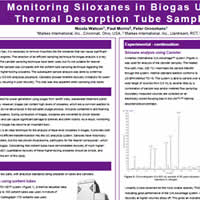Resumo do Pôster:
1. Introduction
There is an increased need for power generation using biogas from landfill sites, wastewater treatment plants and anaerobic digesters. However, biogas can contain high levels of siloxanes, which are a common addition to consumer products and do not decompose in the activated sludge process. Silicones contained in anti-foaming agents biodegrade to siloxanes. During combustion of biogas, siloxanes are converted to silicon dioxide particles, which build up and can cause significant damage to turbines and other motors. As a result, monitoring the levels of siloxanes in biogas has become an important topic.
Thermal desorption (TD) is an ideal technique for the analysis of trace-level siloxanes in biogas. It provides both analyte concentration and efficient transfer/injection into the GC analytical system. Samples have historically been collected with canisters, but this has proven troublesome, particularly for the heavier compounds1, which are major impurities of biogas. Considering that sorbent tubes have demonstrated recovery of much higher-boiling VOCs (up to n-C40)2, quantitative recovery of these higher-boiling siloxanes should be simple, and demonstrating this was the aim of this study.
2. Purpose
Compare the quantitative recovery of higher-boiling siloxanes by sorbent tubes and canisters.
3. Method
The study was split into two parts, with analytical standards being prepared on tubes and canisters, respectively. For the tube samples a nominal 1000 ng/µL bulk liquid solution was prepared in methanol with the analytes in Table 1. Standards were prepared over the range 10-1000 ng/µL and 1 µL of each was spiked onto sorbent tubes with a mixture of Carbograph 2TD and Carbograph 1TD. An automated thermal desorption system that features an electrically cooled cold trap, dispensing liquid cryogen, that complies with US EPA Method TO-173, was used.
For canister samples a 6 L Summa canister contained siloxanes and trimethylsilanol at a nominal concentration of 55 ppbv in nitrogen. Volumetric samples were taken from the canister over the range 10-500 mL. A system for the automated analysis of VOCs in canister air and gas, with multiple-canister capacity and cryogen-free operation was used.
Table 1. Composition of liquid and canister standards |
Analyte |
Abbreviation |
Analyte |
Abbreviation |
Trimethylsilanol |
TMS |
Octamethylcyclotetrasiloxane |
D4 |
Hexamethyldisiloxane |
L2 |
Decamethyltetrasiloxane |
L4 |
Hexamethylcyclotrisiloxane |
D3 |
Decamethylcyclopentasiloxane |
D5 |
Octamethyltrisiloxane |
L3 |
Dodecamethylpentasiloxane |
L5 |
4. Results and Discussion
Sorbent tubes: In the obtained chromatograms, good resolution was observed for all the siloxanes in the mix, including the heaviest, D5 and L5. Interestingly, a large amount of D4 was observed, indicating an impurity in the standard solution. TMS was present in much lower quantity than the siloxanes. Indeed, it had completely disappeared upon later re-analysis, confirmimg its instability in methanolic solutions. Good linearity was observed across the range for all compounds, but TMS was not linear due to its degradation in the standard solution.
Canister: The obtained chromatograms showed a quite marked difference between the tube and canister samples. The absence or low recovery of the least volatile siloxanes (L4, D5 e L5) is quite apparent from the canister sample, and is demonstrated further by the drop-off in response for the linearity studies. Linearity was best observed for the most volatile species, TMS and L2. As the volatility reduces, so does the linearity, as recovery at higher volumes drops off. This gives an indication that recovery of semi-volatile siloxanes is more difficult from canisters than tubes.
Future work will be to collect real-world samples, and compare sorbent tubes with canister samples directly. The effect of matrix on the samples will also be considered, as landfill biogas is highly humid. Tubes with hydrophobic graphitized carbon black sorbents will be used. Sample sizes will also be kept low to avoid collection of excess of water on the tubes, aided by dry-purging of the tubes to help remove any residual water prior to chromatography.
5. Conclusion
This study demonstrate that tube and canister sampling can be used to sample siloxanes. There is clear evidence that canisters show inherent recovery limitations for lower-volatile siloxane species, resulting in poor recovery. This bias is less apparent when sampling onto sorbent tubes.
6. References
- S. Saeed et al., Comparison of impinger and canister methods for the determination of siloxanes in air, AMWA Symposium of Air Quality Measurement Methods and Technology, San Francisco, CA, 13–15 November 2002.
- Markes International, Application Note 053, Quantitative recovery of high boiling point (>450 °C) semi-volatiles organic compounds using thermal desorption coupled to GC-MS.
- US EPA Method TO-17 - Determination of volatile organic compounds in ambient air using active sampling onto sorbent tubes.
|

